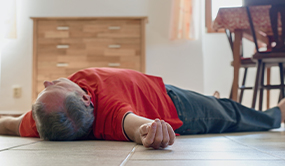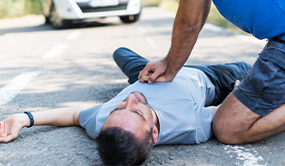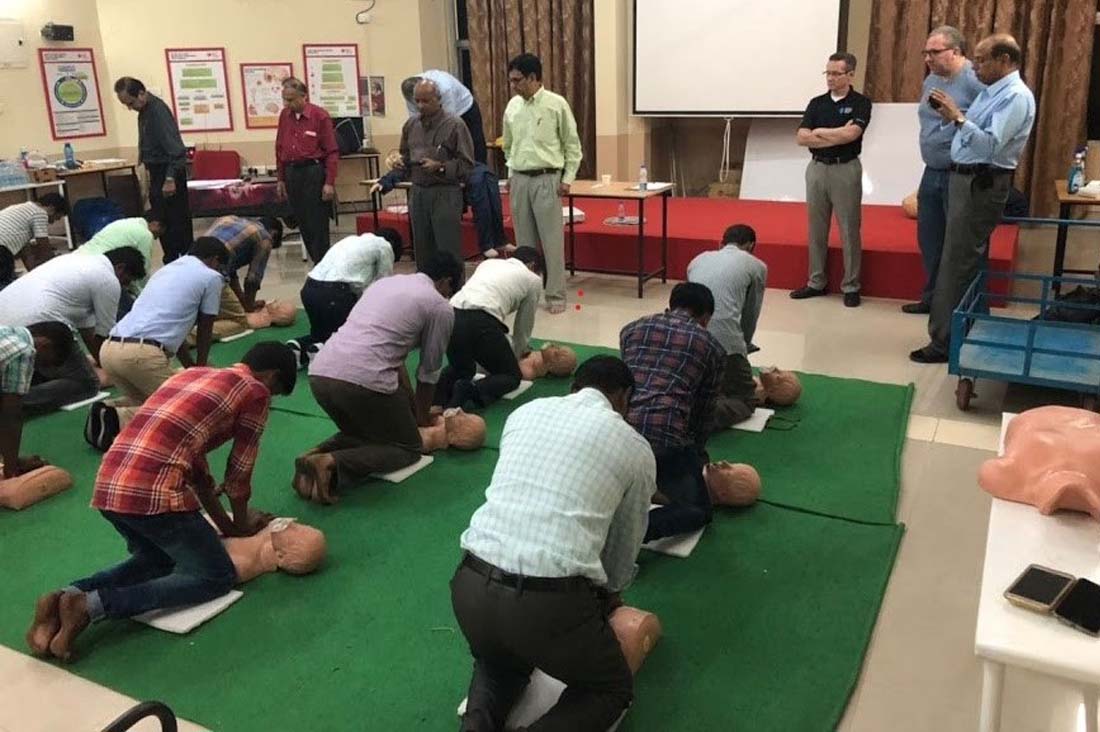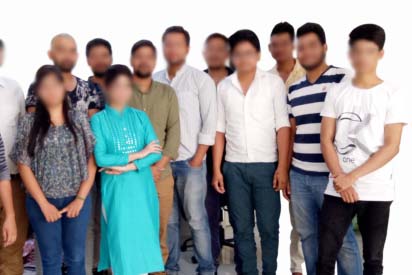All of a sudden, someone collapses and is found unconscious with no breathing…
This means a Sudden Cardiac Arrest has occurred & it's the cause of over 7 lakh deaths per year in India…
It can happen due to a heart attack or coronary artery disease or an undiagnosed heart condition…
Many among them could have been saved if CPR was carried out immediately followed by Defibrillation!
Learning CPR is easy & everyone should get trained, so that one can act instantly when necessary!!
Each year, over 7 lakh Indians die due to Sudden Cardiac Arrest and 50% or more among them could be saved if CPR is administered immediately…
All of a sudden, you may see someone collapse at home or at the mall or out on the street. If the victim is unconscious and is not breathing, it means that he or she has suffered a Sudden Cardiac Arrest (SCA). This will lead to death in a few minutes because due to SCA heart stops pumping and oxygen-rich blood stops flowing to brain and other vital organs. Without oxygen, brain cells can survive only for 6 minutes


There is a narrow window of 5-6 minutes, within which time administration of CPR has to commence…
To save life, Cardio Pulmonary Resuscitation (CPR) has to be commenced urgently. CPR’s chest compressions ensure that blood already oxygenated keeps flowing through the body. Rescue breaths (mouth-to-mouth), if given, provide more oxygen to the body. If Automated External Defibrillator (AED) is available in the vicinity, it must be pressed into use to deliver an electrical shock to the heart to restore its normal rhythm.
To administer CPR & operate AED, you need to participate in a simple training programme of short duration…
CPR & AED training is a part of Basic Life Support (BLS) training and duration varies from a few hours to a day. BLS training is offered by NGOs, organisations and hospitals either free-of-cost or at low charges. Training is available in many cities of India. Individuals can attend training at trainer’s premises. Groups, organisations, schools, colleges and companies have the option of getting trained at their own premises or at trainer’s premises.


Everyone can join in this campaign, undergo training and perform the noble task of saving lives…
Individuals, housewives, roadside vendors, social workers, traffic policemen, firemen, bus drivers, cab and auto drivers, tour guides, security personnel, working professionals, school teachers, school and college students can all get trained. The training will come in handy when Sudden Cardiac Arrest strikes someone at home or elsewhere.

Rush to the victim who has collapsed. Ask a bystander or family member to call for an ambulance (preferably a cardiac ambulance, which will have a defibrillator). If victim is unconscious, call out loudly and/or shake gently.
If there is no response, check he or she is breathing. If breathing has ceased, it means that the victim has suffered a Sudden Cardiac Arrest. Immediately and without a moment's delay, you need to implement steps listed below.
Rush to the victim who has collapsed. Ask a bystander or family member to call for an ambulance (preferably a cardiac ambulance, which will have a defibrillator). If victim is unconscious, call out loudly and/or shake gently. Should there be no response, check is he or she is breathing. If breathing has ceased, it means that the victim has suffered a Sudden Cardiac Arrest.

Gently roll the victim to lay him or her on the back on a flat surface. Tilt the head, lift the chin and open the mouth to ensure that the airway is clear. Place the heal of your hand on the breast bone at the centre of the victim’s chest. Place your other hand on top of your first hand and interlock your fingers.
Start CPR using your body weight to press straight down on the victim’s chest without bending the elbows. on the victim’s chest without bending the elbows. Continue the rate of 100 to 120 chest compressions per minute. During each compression, the chest must go down by 2 inches, before it bounces back.
Gently roll the victim to lay him or her on the back on a flat surface. Tilt the head, lift the chin and open the mouth to ensure that the airway is clear. Place the heal of your hand on the breast bone at the centre of the victim’s chest. Place your other hand on top of your first hand and interlock your fingers. Start CPR using your body

While CPR is going on, check if any AED is available nearby. If one is found, while continuing CPR, connect the AED to the victim through the pads provided. Now interrupt CPR & allow the AED to analyze.
If shock is indicated by AED, stay clear from the victim & apply the shock. Stop CPR if victim revives. If not, continue with CPR and give shock/s as instructed by AED.

In a case of non-availability of AED, just continue with CPR. If CPR-giver gets tired, someone else can take over at any time. This should go on until the ambulance arrives. Thereafter, the ambulance staff will carry out CPR and use AED.
This would go on indefinitely until victim revives. If the ambulance doesn’t have an AED, medical staff will continue CPR in the moving ambulance and AED usage will take place after the ambulance reaches hospital, after which hospital staff takes over.
In a case of non-availability of AED, just continue with CPR. If CPR-giver gets tired, someone else can take over at any time. This should go on until the ambulance arrives. Thereafter, the ambulance staff will carry out CPR and use AED. This would go on indefinitely until victim revives.
Traditional CPR involves 2 mouth-to-mouth breaths after every 30 chest compressions. However, this has to be performed by a responder who has undergone CPR training.
The untrained rescuer should carry-out chest compressions only, without attempting to give breaths. This is known as 'Compression-Only CPR' or 'Hands-Only CPR'.

To generate awareness on the importance of CPR and AED, so that people come forward to learn the CPR technique and handling of AEDs. And on being so trained to assist Sudden Cardiac Arrest victims.

To co-ordinate CPR & AED training for individuals as well as groups, companies, housing societies, schools, colleges, Govt Depts and organisations

To interact with hospitals, training organisations and NGOs so that they come forward to impart CPR & AED training free-of-cost or at nominal costs, in all major cities of India.

To disseminate news stories on real-life incidents wherein people where able to save lives by performing CPR on victims of Sudden Cardiac Arrest in various parts of India.
Dr Swadeep Srivastava
Founder
Heal Foundation
Dr SSC Chakrarao
Chairman
Indian Resuscitation Council
Neeraj Bhalla
Director and Senior Consultant Cardiology
BLK Super Speciality Hospital
Dr Vanita Arora
Head Cardiac Electrophysiology
Max Super Speciality Hospital
Dr Naresh Trehan
Chairman
Medanta Medicity
Dr Santanu Sen
President
Indian Medical Association